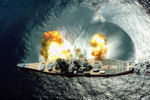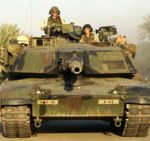Military: Difference between revisions
imported>Derek Hodges (avoided redirect) Tag: Reverted |
imported>Howard C. Berkowitz Tag: Reverted |
||
| Line 12: | Line 12: | ||
===Armed Forces of the [[United States of America]]=== | ===Armed Forces of the [[United States of America]]=== | ||
The Armed Forces of the United States of America are an all-volunteer | The Armed Forces of the United States of America are an all-volunteer professional force, and are divided into several branches and departments based on the capabilities they bring to the [[battle]]. | ||
These branches - also called "services" - include: | These branches - also called "services" - include: | ||
* The [[United States Air Force]] | * The [[United States Air Force]] | ||
* The [[United States Army]] | * The [[United States Army]] | ||
* The [[United States Navy]] | * The [[United States Navy]] | ||
* The [[United States Coast Guard]] | * The [[United States Coast Guard]] (uniformed service, but part of the [[Department of Homeland Security]], rather than the [[Department of Defense]], other than under full national mobilization | ||
* The [[United States Marine Corps]] | * The [[United States Marine Corps]] | ||
Actual combat operations almost invariably involve multiple services, and the operational chain of command does not run through the services, but from the [[National Command Authority]] to regional and functional [[Unified Combatant Command]]s. [[United States Special Operations Command]] is multiservice, but, given the need for low-intensity and covert operations, special operations has effectively become an independent service. | |||
===Armed Forces of the [[United Kingdom]]=== | ===Armed Forces of the [[United Kingdom]]=== | ||
Revision as of 19:30, 16 May 2009


The Military, in a general sense, refers to the standing armed forces of a country, that are directed by the national government and are tasked with that nation's defense. "Militaries" are generally divided into different branches of a specific type of service, including (in alphabetical order) an Air Force (specifically for Aircraft- or Space-based operations), an Army (for land operations), or a Navy (for operations at sea).
Examples of Military Forces
Here listed are several examples of current Military forces.
Armed Forces of Canada
The three traditional services (Navy, Army, and Air Force) were merged in Canada into a single service known as the Canadian Forces on 1 February 1968. Despite an attempt to meld the three services into one, institutional friction prevented this theoretical ideal from becoming a reality. In the mid 1980s, the services began to extend their individuality once more, most notably by the adoption of distinctive uniforms (the Distinctive Environmental Uniform, or DEU). The services are represented today by Air Command, Land Force Command, and Maritime Command, though the terms "navy", "army" and "air force" are used colloquially and are gaining favour. The previous official titles had been Royal Canadian Navy, Canadian Army and Royal Canadian Air Force.
Armed Forces of the United States of America
The Armed Forces of the United States of America are an all-volunteer professional force, and are divided into several branches and departments based on the capabilities they bring to the battle. These branches - also called "services" - include:
- The United States Air Force
- The United States Army
- The United States Navy
- The United States Coast Guard (uniformed service, but part of the Department of Homeland Security, rather than the Department of Defense, other than under full national mobilization
- The United States Marine Corps
Actual combat operations almost invariably involve multiple services, and the operational chain of command does not run through the services, but from the National Command Authority to regional and functional Unified Combatant Commands. United States Special Operations Command is multiservice, but, given the need for low-intensity and covert operations, special operations has effectively become an independent service.
Armed Forces of the United Kingdom
(commonly known as the British Armed Forces)
- The British Army
- The Royal Air Force
- The Royal Navy
Professionalism and motivation
Military culture includes the ability to look at another soldier's uniform and see much about them, in the various insignia of military rank, badges indicating skills and specialties, and awards. Napoleon said "A soldier will fight long and hard for a bit of colored ribbon."
Professional military organizations have extensive education systems, and teaching and mentoring is a requirement of leadership.
